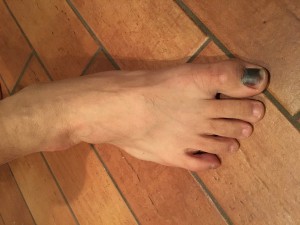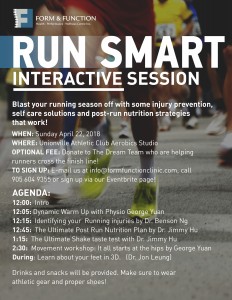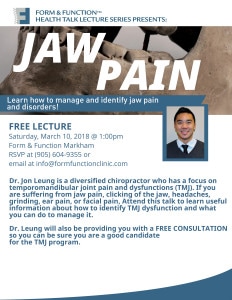Markham Location – News & Announcements
Avoid Losing Toenails!

As most long distance runners know, it is not uncommon to lose a toenail…or two. It is caused by bruising that develops as a result of the repetitive impact between the toenail and the shoe and/or ground. As the nail grows, it lifts off from the nailbed underneath and can eventually fall off. So how can you avoid this from happening at all?
- Make sure you keep your toenails short. The longer the nail, the more likely it is to hit the ground or your shoe causing the bruising.
- Buy running shoes a half size larger than your usual size. This leaves a bit of extra room between the foot and the shoe, lessening the chance of impact.
- Check the shape of your shoes. Avoid shoes with a tapered or narrow toe-box, and look for shoes that have a square shaped toe-box.
Exercise Recommendations
It is important to incorporate physical activity in our daily lives. The American College of Sports Medicine has released new recommendations on the quantity and quality of exercises categorized by cardiorespiratory, resistance, flexibility, and neuromotor exercises.
The recommendations are as follows:
- Cardiorespiratory exercises: Adults should get at least 150 minutes of moderate-intensity exercise per week.
- Resistance exercises: Adults should train each major muscle group two or three days each week using a variety of exercises and equipment.
- Flexibility exercises: Adults should do flexibility exercises at least two or three days each week to improve range of motion.
- Neuromotor exercises: Neuromotor exercise (sometimes called “functional fitness training”) involving balance, agility, and coordination is recommended for two or three days per week.
Ways to Prevent Job Stress

- Take frequent breaks when you find yourself procrastinating, daydreaming, have a mental block or just feeling tense in general.If your task requires more concentration, take more breaks.
- Set your proirities every morning. Have a list and sort them from high to low priority. Make sure you can complete at least one of the high priority items, even if you have to say no to a low priotiy item.
- Make a day where you can clean up your desk, sort your mail, and return phone calls, preferrably on a Friday, so you can start your next week fresh.
- Try to avoid stressful / unneccessary meetings that you can accomplish by a quick call or memo.
Balance!
The Mind Muscle Connection

When you lift in the gym you’re working with a progressive overload principle. You want your muscles to perform some work and eventually fatigue, so when you recover from your session in the gym, your muscle grows so that the work becomes easier. To maximize muscle growth, there’s something that most people are missing. The Mind Muscle Connection. Focus on the muscle being trained as it increases activation of the target muscle. Concentrate on what you are doing and be present in the moment. This is mindfulness at its best. There are a number of distractions in the gym. Your phone. The TV. Your last business meeting. It’s distracting and unproductive. Lifting the weights is just a means to an end. How well you contract the muscles and how much the rebuild is what training is all about. Try these 3 tips to build a better connection with your muscles.
- Cueing Mantra
- Use a few impactful words to help you with each and every lift. Each lift has a few phases. Getting into the start position. A good middle position. Performing the lift with intent. Figure out what your weaknesses or mistakes may be and focus on eliminating those. For example, when doing a deadlift:
- Back. Drive. – Tighten your core muscles and increase your intra-abdominal pressure. Pull your shoulderblades back and down. Drive through the ground.
- Mini-Goals
- Make minigoals that are objective, challenging and attainable but focused on each set. Use your imagination here. An example is a performance goal. Setting a total-rep performance goal at the beginning for your training session may give you the drive to push the last few reps out at the end of your session. Make sure to pick the right exercise and a rep range you can handle. Keep lifting until you hit it! Don’t overwhelm yourself with a million deadlifts, instead try 100 pushups as an adjunct to your chest days.
- Keep it slow and simple
- Don’t rush your reps. Don’t simply go into a set to get the set done. Take your time and make every set count. Focus on each and every rep, your muscle and how your body feels in response to the rep. Let’s use the bench press as an example. After you lower the weight to hit a precise point directly above your chest. Take a second or two, live in the tension, concentrate on your chest and press the weight back up. Take a moment to reset the tension in your chest at the top, focus again and lower it to the same exact point. Eventually this will become part of every exercise you do. Stay focused, forget the work you have to do, cut the distractions out and focus on the task at hand and your training sessions will be more productive and you’ll leave the gym in a mindful state.
Lift with proper form!
The main thing that will provide safe form when it comes to lifting is the idea of maintaining a “lumbar lordosis”. The region called the lumbar spine starts just above the lowest ribs that you can feel on your back and ends approximately at the top of the buttocks. When most of us stand, it can be seen that this area is curved (with the concavity facing back) When we simply bend at the waist this curve starts to reverse, which raises the pressure in the discs (the gel-like mass between the vertebral bones). Placing an object of substantial weight in one’s hands adds to this pressure. So how do we lift to avoid this?Get close to the object with your legs shoulder width, or a bit more, apart. Lower your body while keeping your back relatively straight…you will lose your lordosis only slightly as you go down. Test the load to see how heavy it is by just picking it up less than an inch. Now you are ready for the lift itself. Place the load in your arms comfortably and even before you start to go up, pull it as close to your pelvis and belly as you can. By pushing up using your strong thigh and buttocks muscles and keeping your back as straight as you can, execute the lift.







